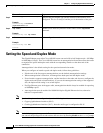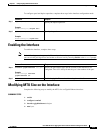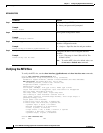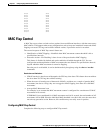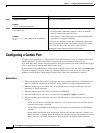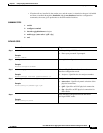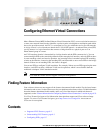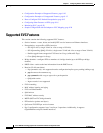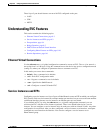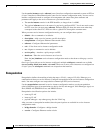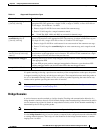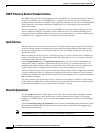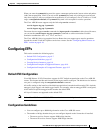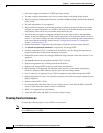
CHAPTER
8-1
Cisco ASR 901 Series Aggregation Services Router Software Configuration Guide
OL-23826-09
8
Configuring Ethernet Virtual Connections
Metro-Ethernet Forum (MEF) defines Ethernet Virtual Connection (EVC) as an association between two
or more user network interfaces that identifies a point-to-point or multipoint-to-multipoint path within
the service provider network. An EVC is a conceptual service pipe within the service provider network.
A bridge domain is a local broadcast domain that is VLAN-ID-agnostic. An ethernet flow point (EFP)
service instance is a logical interface that connects a bridge domain to a physical port or to an
EtherChannel group in a router.
An EVC broadcast domain is determined by a bridge domain and the EFPs connected to it. You can
connect multiple EFPs to the same bridge domain on the same physical interface, and each EFP can have
its own matching criteria and rewrite operation. An incoming frame is matched against EFP matching
criteria on the interface, learned on the matching EFP, and forwarded to one or more EFPs in the bridge
domain. If there are no matching EFPs, the frame is dropped.
You can use EFPs to configure VLAN translation. For example, if there are two EFPs egressing the same
interface, each EFP can have a different VLAN rewrite operation, which is more flexible than the
traditional switchport VLAN translation model.
Note Cisco ASR 901 router does not support switch port configuration.
Finding Feature Information
Your software release may not support all the features documented in this module. For the latest feature
information and caveats, see the release notes for your platform and software release. To find information
about the features documented in this module, and to see a list of the releases in which each feature is
supported, see the “Feature Information for Configuring Ethernet Virtual Connections” section on page 8-33.
Use Cisco Feature Navigator to find information about platform support and Cisco software image
support. To access Cisco Feature Navigator, go to http://www.cisco.com/go/cfn. An account on
Cisco.com is not required.
Contents
• Supported EVC Features, page 8-2
• Understanding EVC Features, page 8-3
• Configuring EFPs, page 8-7




